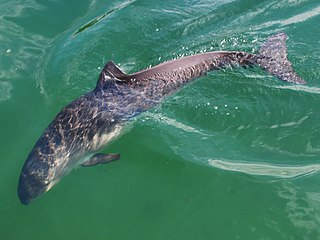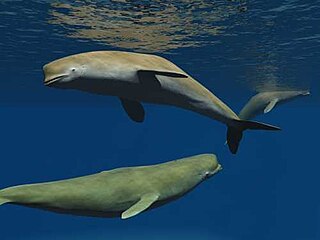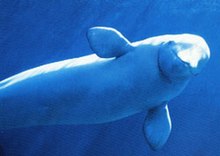
Porpoises are small dolphin-like cetaceans classified under the family Phocoenidae. Although similar in appearance to dolphins, they are more closely related to narwhals and belugas than to the true dolphins. There are eight extant species of porpoise, all among the smallest of the toothed whales. Porpoises are distinguished from dolphins by their flattened, spade-shaped teeth distinct from the conical teeth of dolphins, and lack of a pronounced beak, although some dolphins also lack a pronounced beak. Porpoises, and other cetaceans, belong to the clade Cetartiodactyla with even-toed ungulates.

The narwhal, is a species of toothed whale. It is a member of the family Monodontidae, and the only species in the genus Monodon. The most prominent feature of the species is an adult male's long single tusk that can be up to 3 m (9.8 ft). The narwhal has a mottled pigmentation, with blackish-brown markings over a white background. An adult narwhal is typically 3.0 to 5.5 m in length and 800 to 1,600 kg in weight. Instead of a dorsal fin, it possesses a shallow dorsal ridge. It is a social animal, and may associate in groups of up to 20 members. Carl Linnaeus scientifically described the species in 1758 in his work Systema Naturae.

The beluga whale is an Arctic and sub-Arctic cetacean. It is one of two members of the family Monodontidae, along with the narwhal, and the only member of the genus Delphinapterus. It is also known as the white whale, as it is the only cetacean to regularly occur with this colour; the sea canary, due to its high-pitched calls; and the melonhead, though that more commonly refers to the melon-headed whale, which is an oceanic dolphin.

The Cetruminantia are a clade made up of the Cetancodontamorpha and their closest living relatives, the Ruminantia.

Delphinoidea is the largest group of toothed whales with 66 genera in 6 families. The largest living member of the superfamily is the killer whale, which can reach 6 tons, while the smallest is the vaquita.

Artiofabula is a clade made up of the Suina and the Cetruminantia. The clade was found in molecular phylogenetic analyses and contradicted traditional relationships based on morphological analyses.

Bohaskaia is an extinct genus of beluga-like odontocete cetacean known from the Early Pliocene of Virginia and North Carolina, United States. It was first named by Jorge Vélez-Juarbe and Nicholas D. Pyenson in 2012 and the type species is Bohaskaia monodontoides.

Lophocetus is an extinct genus of dolphin belonging to the clade Delphinida that is known from late Miocene (Tortonian) marine deposits in California and Maryland. Although usually placed in Kentriodontidae, recent studies have found it only distantly related to Kentriodon.
Eodelphinus is an extinct genus of oceanic dolphins belonging to the family Delphinidae.
Casatia is a genus of extinct cetacean from the Early Pliocene, approximately between 5.1 and 4.5 million years ago. The genus contains a single species, C. thermophila. It was described from a partial skull. Its closest relatives are the narwhal and beluga, yet the remains were found farther south than its relatives, supporting the theory that monodontids evolved from warm water genera before becoming adapted to cold water.

A narluga is a hybrid born from mating a female narwhal and a male beluga whale. Narwhals and beluga whales are both cetaceans found in the High Arctic and are the only two living members of the family Monodontidae.










